您好,登錄后才能下訂單哦!
您好,登錄后才能下訂單哦!
手寫數字識別算法的設計與實現
本文使用python基于TensorFlow設計手寫數字識別算法,并編程實現GUI界面,構建手寫數字識別系統。這是本人的本科畢業論文課題,當然,這個也是機器學習的基本問題。本博文不會以論文的形式展現,而是以編程實戰完成機器學習項目的角度去描述。
項目要求:本文主要解決的問題是手寫數字識別,最終要完成一個識別系統。
設計識別率高的算法,實現快速識別的系統。
1 LeNet-5模型的介紹
本文實現手寫數字識別,使用的是卷積神經網絡,建模思想來自LeNet-5,如下圖所示:
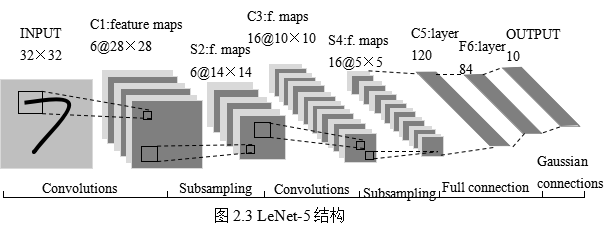
這是原始的應用于手寫數字識別的網絡,我認為這也是最簡單的深度網絡。
LeNet-5不包括輸入,一共7層,較低層由卷積層和最大池化層交替構成,更高層則是全連接和高斯連接。
LeNet-5的輸入與BP神經網路的不一樣。這里假設圖像是黑白的,那么LeNet-5的輸入是一個32*32的二維矩陣。同時,輸入與下一層并不是全連接的,而是進行稀疏連接。本層每個神經元的輸入來自于前一層神經元的局部區域(5×5),卷積核對原始圖像卷積的結果加上相應的閾值,得出的結果再經過激活函數處理,輸出即形成卷積層(C層)。卷積層中的每個特征映射都各自共享權重和閾值,這樣能大大減少訓練開銷。降采樣層(S層)為減少數據量同時保存有用信息,進行亞抽樣。
第一個卷積層(C1層)由6個特征映射構成,每個特征映射是一個28×28的神經元陣列,其中每個神經元負責從5×5的區域通過卷積濾波器提取局部特征。一般情況下,濾波器數量越多,就會得出越多的特征映射,反映越多的原始圖像的特征。本層訓練參數共6×(5×5+1)=156個,每個像素點都是由上層5×5=25個像素點和1個閾值連接計算所得,共28×28×156=122304個連接。
S2層是對應上述6個特征映射的降采樣層(pooling層)。pooling層的實現方法有兩種,分別是max-pooling和mean-pooling,LeNet-5采用的是mean-pooling,即取n×n區域內像素的均值。C1通過2×2的窗口區域像素求均值再加上本層的閾值,然后經過激活函數的處理,得到S2層。pooling的實現,在保存圖片信息的基礎上,減少了權重參數,降低了計算成本,還能控制過擬合。本層學習參數共有1*6+6=12個,S2中的每個像素都與C1層中的2×2個像素和1個閾值相連,共6×(2×2+1)×14×14=5880個連接。
S2層和C3層的連接比較復雜。C3卷積層是由16個大小為10×10的特征映射組成的,當中的每個特征映射與S2層的若干個特征映射的局部感受野(大小為5×5)相連。其中,前6個特征映射與S2層連續3個特征映射相連,后面接著的6個映射與S2層的連續的4個特征映射相連,然后的3個特征映射與S2層不連續的4個特征映射相連,最后一個映射與S2層的所有特征映射相連。此處卷積核大小為5×5,所以學習參數共有6×(3×5×5+1)+9×(4×5×5+1)+1×(6×5×5+1)=1516個參數。而圖像大小為28×28,因此共有151600個連接。
S4層是對C3層進行的降采樣,與S2同理,學習參數有16×1+16=32個,同時共有16×(2×2+1)×5×5=2000個連接。
C5層是由120個大小為1×1的特征映射組成的卷積層,而且S4層與C5層是全連接的,因此學習參數總個數為120×(16×25+1)=48120個。
F6是與C5全連接的84個神經元,所以共有84×(120+1)=10164個學習參數。
卷積神經網絡通過通過稀疏連接和共享權重和閾值,大大減少了計算的開銷,同時,pooling的實現,一定程度上減少了過擬合問題的出現,非常適合用于圖像的處理和識別。
2 手寫數字識別算法模型的構建
2.1 各層設計
有了第一節的基礎知識,在這基礎上,進行完善和改進。
輸入層設計
輸入為28×28的矩陣,而不是向量。
激活函數的選取
Sigmoid函數具有光滑性、魯棒性和其導數可用自身表示的優點,但其運算涉及指數運算,反向傳播求誤差梯度時,求導又涉及乘除運算,計算量相對較大。同時,針對本文構建的含有兩層卷積層和降采樣層,由于sgmoid函數自身的特性,在反向傳播時,很容易出現梯度消失的情況,從而難以完成網絡的訓練。因此,本文設計的網絡使用ReLU函數作為激活函數。
ReLU的表達式:
卷積層設計
本文設計卷積神經網絡采取的是離散卷積,卷積步長為1,即水平和垂直方向每次運算完,移動一個像素。卷積核大小為5×5。
降采樣層
本文降采樣層的pooling方式是max-pooling,大小為2×2。
輸出層設計
輸出層設置為10個神經網絡節點。數字0~9的目標向量如下表所示:
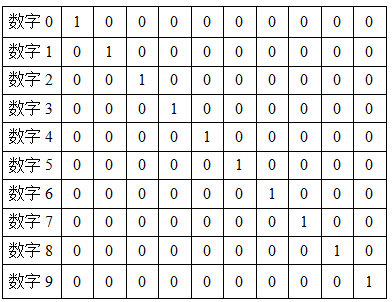
2.2 網絡模型的總體結構
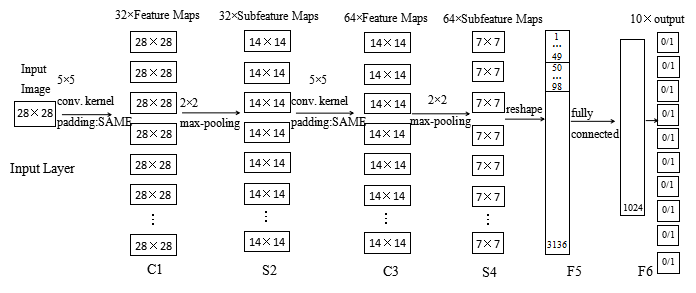
其實,本文網絡的構建,參考自TensorFlow的手寫數字識別的官方教程的,讀者有興趣也可以詳細閱讀。
2.3 編程實現算法
本文使用Python,調用TensorFlow的api完成手寫數字識別的算法。
注:本文程序運行環境是:Win10,python3.5.2。當然,也可以在Linux下運行,由于TensorFlow對py2和py3兼容得比較好,在Linux下可以在python2.7中運行。
#!/usr/bin/env python2
# -*- coding: utf-8 -*-
"""
Created on Fri Feb 17 19:50:49 2017
@author: Yonghao Huang
"""
#import modules
import numpy as np
import matplotlib.pyplot as plt
#from sklearn.metrics import confusion_matrix
import tensorflow as tf
import time
from datetime import timedelta
import math
from tensorflow.examples.tutorials.mnist import input_data
def new_weights(shape):
return tf.Variable(tf.truncated_normal(shape,stddev=0.05))
def new_biases(length):
return tf.Variable(tf.constant(0.1,shape=length))
def conv2d(x,W):
return tf.nn.conv2d(x,W,strides=[1,1,1,1],padding='SAME')
def max_pool_2x2(inputx):
return tf.nn.max_pool(inputx,ksize=[1,2,2,1],strides=[1,2,2,1],padding='SAME')
#import data
data = input_data.read_data_sets("./data", one_hot=True) # one_hot means [0 0 1 0 0 0 0 0 0 0] stands for 2
print("Size of:")
print("--Training-set:\t\t{}".format(len(data.train.labels)))
print("--Testing-set:\t\t{}".format(len(data.test.labels)))
print("--Validation-set:\t\t{}".format(len(data.validation.labels)))
data.test.cls = np.argmax(data.test.labels,axis=1) # show the real test labels: [7 2 1 ..., 4 5 6], 10000values
x = tf.placeholder("float",shape=[None,784],name='x')
x_image = tf.reshape(x,[-1,28,28,1])
y_true = tf.placeholder("float",shape=[None,10],name='y_true')
y_true_cls = tf.argmax(y_true,dimension=1)
# Conv 1
layer_conv1 = {"weights":new_weights([5,5,1,32]),
"biases":new_biases([32])}
h_conv1 = tf.nn.relu(conv2d(x_image,layer_conv1["weights"])+layer_conv1["biases"])
h_pool1 = max_pool_2x2(h_conv1)
# Conv 2
layer_conv2 = {"weights":new_weights([5,5,32,64]),
"biases":new_biases([64])}
h_conv2 = tf.nn.relu(conv2d(h_pool1,layer_conv2["weights"])+layer_conv2["biases"])
h_pool2 = max_pool_2x2(h_conv2)
# Full-connected layer 1
fc1_layer = {"weights":new_weights([7*7*64,1024]),
"biases":new_biases([1024])}
h_pool2_flat = tf.reshape(h_pool2,[-1,7*7*64])
h_fc1 = tf.nn.relu(tf.matmul(h_pool2_flat,fc1_layer["weights"])+fc1_layer["biases"])
# Droupout Layer
keep_prob = tf.placeholder("float")
h_fc1_drop = tf.nn.dropout(h_fc1,keep_prob)
# Full-connected layer 2
fc2_layer = {"weights":new_weights([1024,10]),
"biases":new_weights([10])}
# Predicted class
y_pred = tf.nn.softmax(tf.matmul(h_fc1_drop,fc2_layer["weights"])+fc2_layer["biases"]) # The output is like [0 0 1 0 0 0 0 0 0 0]
y_pred_cls = tf.argmax(y_pred,dimension=1) # Show the real predict number like '2'
# cost function to be optimized
cross_entropy = -tf.reduce_mean(y_true*tf.log(y_pred))
optimizer = tf.train.AdamOptimizer(learning_rate=1e-4).minimize(cross_entropy)
# Performance Measures
correct_prediction = tf.equal(y_pred_cls,y_true_cls)
accuracy = tf.reduce_mean(tf.cast(correct_prediction,"float"))
with tf.Session() as sess:
init = tf.global_variables_initializer()
sess.run(init)
train_batch_size = 50
def optimize(num_iterations):
total_iterations=0
start_time = time.time()
for i in range(total_iterations,total_iterations+num_iterations):
x_batch,y_true_batch = data.train.next_batch(train_batch_size)
feed_dict_train_op = {x:x_batch,y_true:y_true_batch,keep_prob:0.5}
feed_dict_train = {x:x_batch,y_true:y_true_batch,keep_prob:1.0}
sess.run(optimizer,feed_dict=feed_dict_train_op)
# Print status every 100 iterations.
if i%100==0:
# Calculate the accuracy on the training-set.
acc = sess.run(accuracy,feed_dict=feed_dict_train)
# Message for printing.
msg = "Optimization Iteration:{0:>6}, Training Accuracy: {1:>6.1%}"
# Print it.
print(msg.format(i+1,acc))
# Update the total number of iterations performed
total_iterations += num_iterations
# Ending time
end_time = time.time()
# Difference between start and end_times.
time_dif = end_time-start_time
# Print the time-usage
print("Time usage:"+str(timedelta(seconds=int(round(time_dif)))))
test_batch_size = 256
def print_test_accuracy():
# Number of images in the test-set.
num_test = len(data.test.images)
cls_pred = np.zeros(shape=num_test,dtype=np.int)
i = 0
while i < num_test:
# The ending index for the next batch is denoted j.
j = min(i+test_batch_size,num_test)
# Get the images from the test-set between index i and j
images = data.test.images[i:j, :]
# Get the associated labels
labels = data.test.labels[i:j, :]
# Create a feed-dict with these images and labels.
feed_dict={x:images,y_true:labels,keep_prob:1.0}
# Calculate the predicted class using Tensorflow.
cls_pred[i:j] = sess.run(y_pred_cls,feed_dict=feed_dict)
# Set the start-index for the next batch to the
# end-index of the current batch
i = j
cls_true = data.test.cls
correct = (cls_true==cls_pred)
correct_sum = correct.sum()
acc = float(correct_sum) / num_test
# Print the accuracy
msg = "Accuracy on Test-Set: {0:.1%} ({1}/{2})"
print(msg.format(acc,correct_sum,num_test))
# Performance after 10000 optimization iterations
optimize(num_iterations=10000)
print_test_accuracy()
savew_hl1 = layer_conv1["weights"].eval()
saveb_hl1 = layer_conv1["biases"].eval()
savew_hl2 = layer_conv2["weights"].eval()
saveb_hl2 = layer_conv2["biases"].eval()
savew_fc1 = fc1_layer["weights"].eval()
saveb_fc1 = fc1_layer["biases"].eval()
savew_op = fc2_layer["weights"].eval()
saveb_op = fc2_layer["biases"].eval()
np.save("savew_hl1.npy", savew_hl1)
np.save("saveb_hl1.npy", saveb_hl1)
np.save("savew_hl2.npy", savew_hl2)
np.save("saveb_hl2.npy", saveb_hl2)
np.save("savew_hl3.npy", savew_fc1)
np.save("saveb_hl3.npy", saveb_fc1)
np.save("savew_op.npy", savew_op)
np.save("saveb_op.npy", saveb_op)
運行結果顯示:測試集中準確率大概為99.2%。
我還寫了一些輔助函數,可以查看部分識別錯誤的圖片,
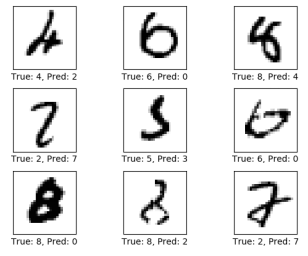
還可以查看混淆矩陣,
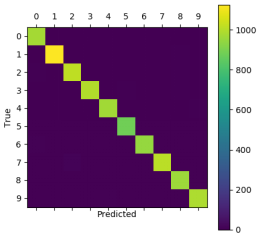
2.3 實現手寫識別系統
最后,將訓練好的參數保存,封裝進一個GUI界面中,形成一個手寫識別系統。
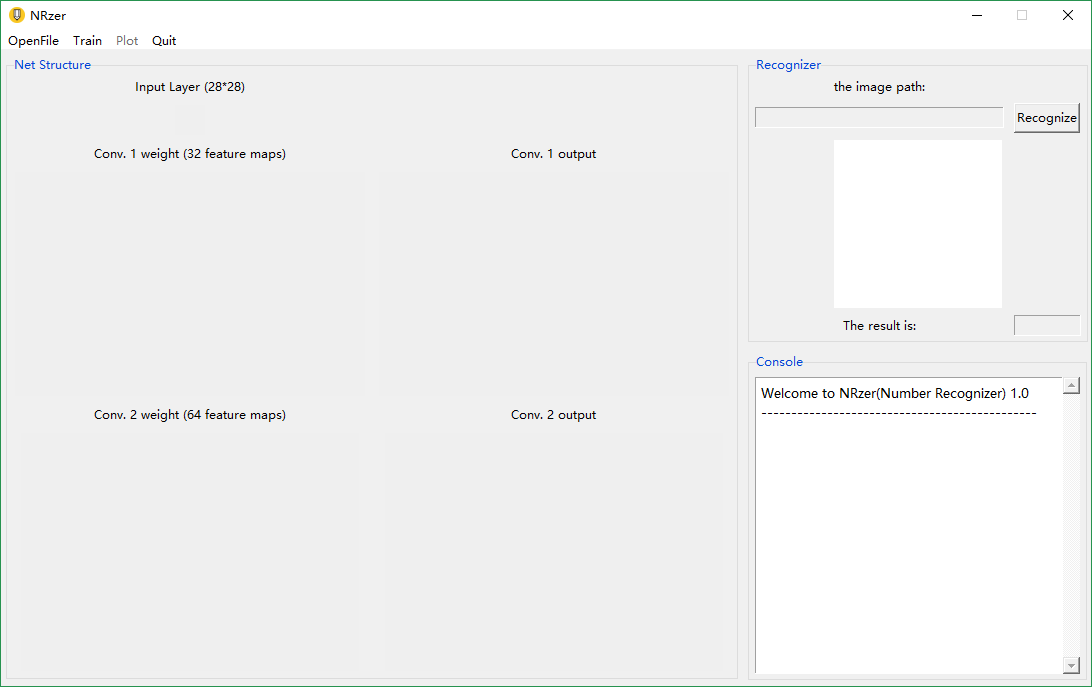
系統中還添加了一點圖像預處理的操作,比如灰度化,圖像信息的歸一化等,更貼近實際應用。
系統可進行快速識別,如下圖
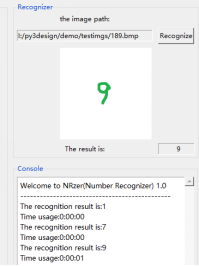
3 總結
本文實現的系統其實是基于卷積神經網絡的手寫數字識別系統。該系統能快速實現手寫數字識別,成功識別率高。缺點:只能正確識別單個數字,圖像預處理還不夠,沒有進行圖像分割,讀者也可以自行添加,進行完善。
4 收獲
本人之前的本科期間,雖然努力學習高數、線性代數和概率論,但是沒有認真學習過機器學習,本人是2017年才開始系統學習機器學習相關知識,而且本科畢業論文也選擇了相關的課題,雖然比較基礎,但是認真完成后,有一種學以致用的滿足感,同時也激勵著我進行更深入的理論學習和實踐探討,與所有讀者共勉。
以上就是本文的全部內容,希望對大家的學習有所幫助,也希望大家多多支持億速云。
免責聲明:本站發布的內容(圖片、視頻和文字)以原創、轉載和分享為主,文章觀點不代表本網站立場,如果涉及侵權請聯系站長郵箱:is@yisu.com進行舉報,并提供相關證據,一經查實,將立刻刪除涉嫌侵權內容。